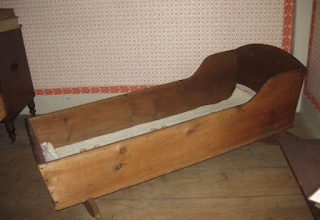 |
| This adult cradle is on display at the Ward House Museum at Harvard University. Photo credit: Ward House Museum |
I'm still processing the loss of my father. Still thinking about how taking care of him in my home changed my life.
I first wrote about the overall challenges of caring for an elderly loved one who had Alzheimer's. This time, I'm focusing on the physical aspects of caring for an adult whose mobility is impaired.
My Dad had lost his balance and the strength of his legs. He needed help moving from chair to bed to bathroom to wheelchair and back. At first, he could shuffle along with the person who held him up and guided him. At the end, he couldn't even manage that.
Even with 21st century aids, physically lifting, guiding, shifting and settling an adult is hard work. It requires use of mobility aids. What did people do before they had in-home Hospice beds adjustable at the click of a button? Or wheelchairs with easily removable and interchangable parts? I assume people in the past were ahead of us in innovations regarding chamber pot chairs. Many pioneer households lacked indoor water closets and/or plumbing.
I came across an interesting online lecture about mobility aids in the late 18th and 19th centuries. It's worth a watch if you're intrigued about these things. "The Material Culture of Living With Disability at Home, 1700-1900" focused on times slightly earlier than the late 19th-early 20th century I write about in this blog. But I figure that, for monetary and accessibility reasons, many settlers in pioneer Florida still relied on time-tested aids. There wasn't any Amazon shipping to the backwoods. And fancy mobility aids were out of reach financially for the average person. Just as they often are today. A top-of-the-line motorized wheelchair today can cost more than $20,000.
Innovation was demanded of people settling a new location such as the Florida frontier. Based on what I learned in the lecture, settlers would have applied that imagination to help incapacitated loved ones.
Invalids usually lived at home with immediate or extended family. Wealthy pioneers could and would hire outside help to handle the heavy lifting. But the onus of providing support usually rested on family members. They did things like add wheels to regular chairs.
Adult cradles are one of the more intriguing adaptations mentioned in the lecture. They allowed an invalid to be part of family life instead of lying in bed all day in a back bedroom. A cradle was more easily moved to a parlor or porch than a bed was. And the cradle provided necessary comfort and support to the disabled person.
Lecturer Nicole Belolan, Ph.D., said the popularity of the cradles declined in the mid-1800s. She also noted they were used primarily along the Eastern Seaboard, from Maine to the Carolinas.
But, then and now, most people in Florida came from somewhere else. I can imagine an early Florida settler keeping a loved one close in an adult cradle long after the furniture's popularity declined. Settling a frontier was often a lonely business. Every human connection counted. As it still does today. Would that we'd remember that.

No comments:
Post a Comment